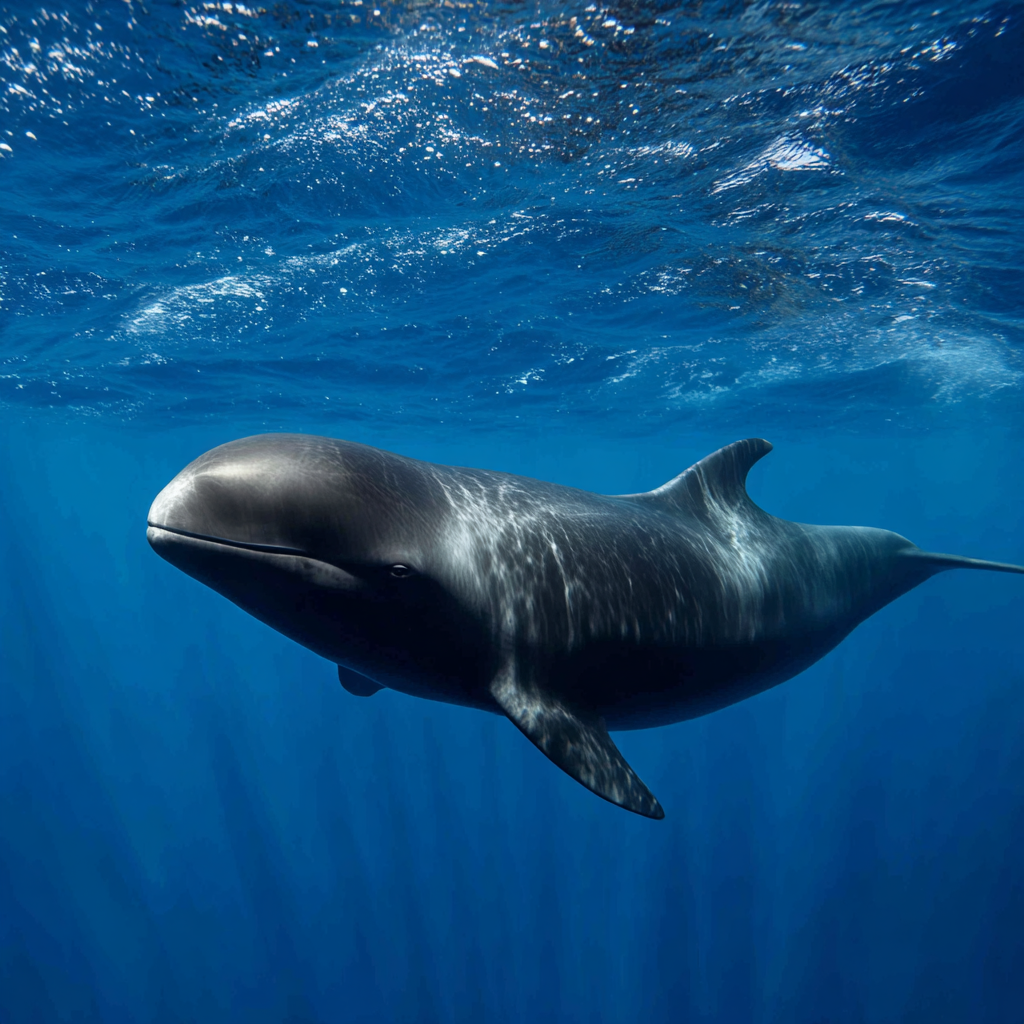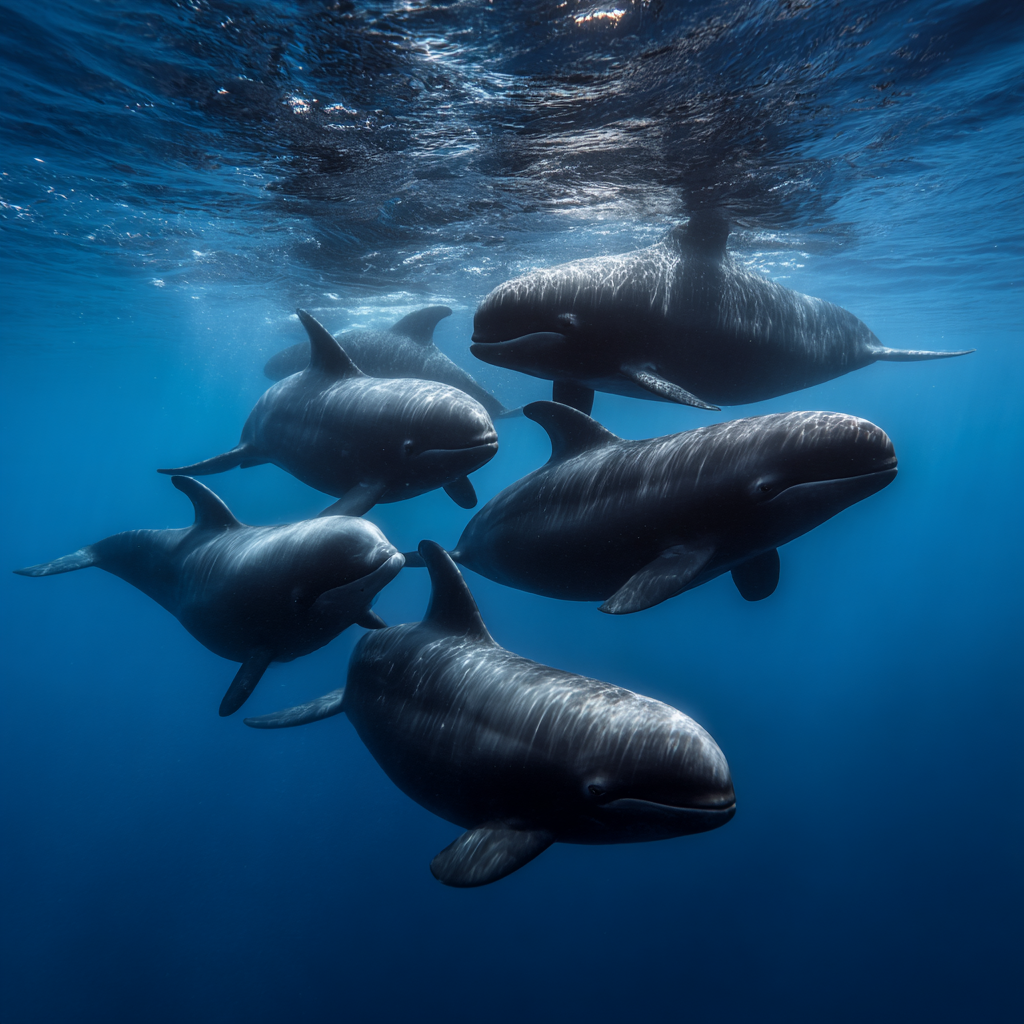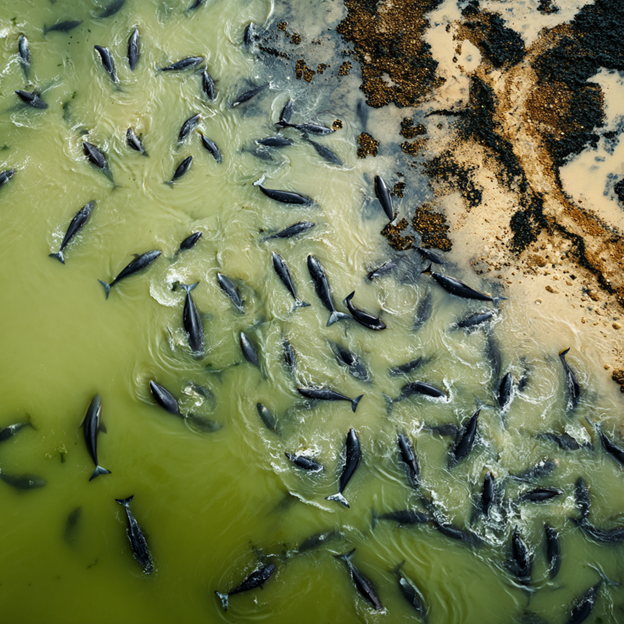The Melon-headed Whale, Peponocephala electra, is a ghost of the deep tropics, a small, dark cetacean that lives its life far from human shores and, consequently, far from human stories. Unlike whales that patrol the coasts and feature in the folklore of ancient mariners, the Melon-headed Whale has no traditional mythology. Its narrative is not found in bestiaries or indigenous legends, but in the scattered data points of modern science and the grim spectacle of mass strandings.
This animal's story is a modern one, defined by what we don't know. It is a creature of immense sociality, gathering in super-pods of a thousand or more, yet we know little of its life cycle or global numbers. Its most profound entry into the human consciousness comes from tragedy—when hundreds of these deep-sea animals suddenly appear, lost and dying in shallow lagoons. These events have created a new kind of myth: a contemporary mystery where the supernatural cause is not a sea monster, but the invisible and pervasive influence of human technology, particularly the deafening sound of military and industrial sonar.
I. Biological Snapshot: A Scientific Profile
Core Identification
- Scientific Name / Genus: Peponocephala electra, Genus Peponocephala, Family Delphinidae
- IUCN Status: Least Concern (globally), due to its widespread distribution and presumed abundance. However, it is highly sensitive to specific threats.
Physical Characteristics
- Length: Up to 2.75 m (9 ft)
- Weight: Up to 275 kg (606 lbs)
- Lifespan: Up to 45 years
- Distinguishing Features: A robust, torpedo-shaped body, often called a "blackfish" due to its dark charcoal-gray coloration. The head is conical and tapering, giving it its "melon-headed" name, with no discernible beak. It has a tall, curved (falcate) dorsal fin and long, sharply pointed flippers. It is often confused with the Pygmy Killer Whale but can be distinguished by its higher tooth count (20-25 pairs in each jaw).
Ecology & Distribution
- Global Population: Unknown, but considered to be common and abundant in its preferred habitat.
- Distribution & Habitat: Found worldwide in deep, offshore tropical and subtropical waters. They rarely venture over the continental shelf but are frequently associated with oceanic islands and archipelagos like Hawaii and the Philippines.
- Diet & Foraging: A nocturnal hunter, feeding on deep-water (mesopelagic) squid, small fish, and crustaceans. They hunt in large, coordinated groups at night, when their prey migrates closer to the surface.
- Reproduction: Very little is known. Gestation is estimated to be around 12 months. Females reach sexual maturity between 7 and 12 years, with males maturing later at 12 to 15 years. They give birth to a single calf every 3 to 4 years.

II. The Mystery of the Mass Stranding
The Melon-headed Whale is almost entirely absent from ancient and indigenous mythology. Its life in the deep ocean kept it beyond the horizon of early human storytelling. Instead, its story is a modern one, forged in tragedy and scientific inquiry. This species is one of the most common to mass strand, an event where a large group, sometimes hundreds of individuals, inexplicably swims into shallow water from which they cannot escape.
These events are deeply mysterious and have given rise to a form of modern folklore. When science cannot provide a definitive cause, speculation rushes in to fill the void. In the absence of ancient sea monsters, a new one has been proposed: the invisible, deafening pulse of anthropogenic sound.
A landmark and tragic event occurred in Madagascar in 2008, when approximately 100 melon-headed whales became trapped in a shallow lagoon system; most of them died. An independent scientific review panel investigated and concluded that the "most plausible and likely behavioral trigger" was a high-power, multi-beam echosounder system being used by a survey vessel for an oil and gas company. This was the first time a mass stranding was so closely linked to this type of mapping sonar, a technology used globally by industry, militaries, and researchers.
The Invisible Monster
This event, and others like it, have created a new mythology for the deep sea. The monster is no longer a physical beast that rises from the depths, but an invisible force—a wall of sound that can cause panic, disorientation, and death. The story of the Melon-headed Whale is thus a cautionary tale of the Anthropocene, where our technological reach extends into the most remote corners of the planet, with consequences we are only beginning to understand.

III. Current Struggle: A Social Animal in a World of Noise and Neglect
While globally listed as a species of "Least Concern" due to its wide range, the Melon-headed Whale faces severe, acute threats that can have devastating impacts on local populations. Its highly social nature and sensitivity to sound make it exceptionally vulnerable to the pressures of the modern ocean.
| Primary Threat | Direct Impact | Ultimate Consequence |
|---|---|---|
| Underwater Noise Pollution | Extreme sensitivity to sound from military sonar, seismic surveys, and high-power mapping systems. | Catastrophic mortality in mass stranding events; abandonment of critical habitats. Can cause panic, disorientation, and behavioral changes that lead to mass strandings. Disrupts communication, foraging, and social cohesion. |
| Fisheries Interactions | Accidental entanglement in fishing gear (bycatch); targeted in drive fisheries and harpoon hunts in some regions (e.g., Japan, Philippines). | Direct, unnatural mortality that can impact local populations. Causes direct injury and mortality. |
| Pollution | Bioaccumulation of chemical pollutants (PCBs, heavy metals); ingestion of plastic debris. | Long-term decline in population health and resilience. Can lead to compromised immune systems, reproductive failure, and death from internal blockages or toxicity. |
| Mass Strandings | The species is prone to stranding in large numbers, often for reasons that remain unknown. | The most visible and devastating outcome of the threats they face, capable of wiping out entire social groups. Their intense social bonds mean that if one animal strands, the entire pod may follow, leading to high mortality. |
A Story of Absence
The story of the Melon-headed Whale is a story of absence—an absence of knowledge, an absence from our traditional stories, and a terrifying, potential absence from our oceans if the threats it faces are not addressed. It is a symbol of the deep mysteries that still remain in our world, and a stark reminder that our actions have consequences that reach far beyond the shore, into the silent, dark places of the sea.

References
- "A species account of the Melon-headed whale (Peponocephala electra)." Mammals of Texas, Natural Science Research Laboratory, Texas Tech University.
- "Melon-headed Whale." CCARO.
- "Melon-headed whale." Whale & Dolphin Conservation USA.
- "Peponocephala electra (Melon-headed Whale)." UWI St. Augustine.
- "Melon-Headed Whale." NOAA Fisheries.
- "Whale mass stranding attributed to sonar mapping for first time." ScienceDaily, September 25, 2013.
- "Sea-map sonar linked to whale stranding off Madagascar." The Guardian, October 15, 2013.
- "Melon-headed whale." Wikipedia.
- "The melon-headed whale, Peponocephala electra, THE IUCN RED LIST OF THREATENED SPECIES™." ResearchGate.
- "Peponocephala electra, Melon-headed whale: fisheries." SeaLifeBase.
- "Galapagos Melon Headed Whale." Quasar Expeditions.
- "Melon-Headed Whale - Facts, Diet, Habitat & Pictures." Animalia.bio.
- "Melon Headed Whales in Hawaiʻi." NOAA Fisheries.